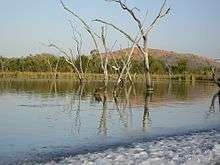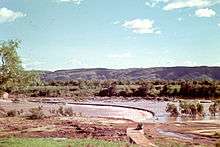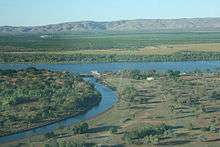Ord River
| Ord River | |
|---|---|
 Ord River from a boat | |
| Country | Australia |
| Basin | |
| Main source |
Kimberley Plateau 531 metres (1,742 ft)[1] |
| River mouth |
Cambridge Gulf, Timor Sea sea level |
| Basin size | 46,100 square kilometres (17,799 sq mi)[2] |
| Physical characteristics | |
| Length | 650 km (400 mi) |
| Discharge |
|
| Features | |
| Tributaries |
|
The Ord River is a 320-kilometre (200 mi) long river in the Kimberley region of Western Australia. The river's catchment covers 46,100 square kilometres (17,799 sq mi).
The lower Ord river and the conjunction with Cambridge Gulf create the most northern estuarine environment in Western Australia [4][5][6]
The Ord River Irrigation Scheme was built in stages during the 20th century. Australia's largest artificial lake by volume, Lake Argyle was completed in 1972. The lower reaches of the river support an important wetland area known as the Ord River Floodplain, a protected area which contains numerous mangrove forests, lagoons, creeks, flats and extensive floodplains.[7]
Naming
It was named in honour of Sir Harry St. George Ord GCMG, CB, RE, Governor of Western Australia from 1877 to 1880, by Alexander Forrest on 2 August 1879.[8] Forrest's journal states.
We are still 300 miles from the telegraph line, and cannot of course tell what difficulties may not yet be in store for us, so I feel bound to push on, at the same time no one can regret more than I do that I am unable to follow this magnificent stream to its mouth which I have no doubt will be found in Cambridge Gulf–the whole of its waters in that case being in Western Australian territory. I have named this river the Ord, after His Excellency the Governor of Western Australia, who has taken so great an interest in this expedition. Marked a tree F 158.[8]
The headwaters of the Ord river are located below the 983 metre Mount Wells and initially flows east and around the edge of Purnululu National Park before heading north through Lake Argyle then passing west of Kununurra and discharging into the Cambridge Gulf, which is at the southern extremity of the Joseph Bonaparte Gulf, Timor Sea. The river has 35 tributaries of which the five longest are Bow River, Nicholson River, Dunham River, Panton River and Negri Rivers.
Ord River Irrigation Scheme


The idea of damming the Ord was first mentioned over 100 years ago, when the Western Australia Commissioner of Tropical Agriculture, Adrian Despeissis, suggested,
Substantial wooden dams constructed on a double row of jarrah piles driven into the bed of the river, with a core wall of puddle clay between, would appear to form suitable weirs.[9]
Between 1935 and 1942 drought affected the Kimberley Pastoral Industry and the Ord Scheme can thank this drought for its existence. The focus in 1937 was that a dam on the Ord could supplement the pastoral industry.[9]
Ord River experimental station
Then Minister for Lands and Agriculture, F J S Wise, in 1937 wrote
..we set a plan in motion during the past twelve months in connection with the establishment of experimental areas on Ivanhoe Station somewhere near Carlton Reach.[9]
Carlton Reach was the largest waterhole in the Kimberley, being naturally dammed and held back by the Bandicoot Bar, a quartzite rock bar that held back the waterhole for many miles forming a natural permanent lake.
By 1941 the Carlton Reach Research Station, also known as the Ord River Experimental Station, was set up by Kimberley Michael Durack for the Western Australia Department of Agriculture with funds, supposedly "siphoned off" from the Kalgoorlie pipeline and assistance from the Western Australia Public Works Department (PWD).[9]
Ord River dam surveys
During August 1941 the newly appointed Director of Works, R. J. Dumas, spent three weeks in the East Kimberley,
...accompanied by F. Forman (Government Geologist). T. Brennan (Acting Engineer for the North West), K. Durack, J. Walker (a half caste aboriginal) and a full blood aboriginal, Jacko[9]
This party travelled by horseback along the Ord River and through the Ord River gorges in the Carr Boyd Range, selecting several possible dam sites. Work continued at the Carlton Reach experimental station for Kim Durack with assistance from his brother William A. Durack, on various agricultural experiments, centred on supplementing the pastoral industry.[9]
Involving the Commonwealth
Early in 1944 Dumas wrote to the Commonwealth Government, advising of the soil, botanical, erosion and engineering surveys about to take place in the East Kimberley, explaining, the project must become largely a national one and any assistance from the Commonwealth would be welcome. By May 1944 there was a large body of agriculturalists, botanists and surveyors carrying out investigations in the vicinity of Carlton Reach.[9] The Aborigines who lived in the Ord River basin were decimated through killing and the spread of introduced diseases.[10]
Establishment of the Kimberley Research Station
It would be another two years before the Commonwealth Government became involved, with the establishment of a joint CSIR and Western Australia Department of Agriculture facility. As the Carlton Reach, Ord River experimental station site was river alluvium (red soil) and most of the surveyed agricultural land was "Cununurra Clay" (blacksoil - Volcanic soil eroded from the Antrim Plateau Volcanics), it was moved to a new site further down river and the new Kimberley Research Station (KRS) was established in 1946.[11]
Justifying dam construction
In 1951, The KRS Supervisory Committee (KRSSC) indicated that sugar and rice were two cash crops that could justify dam construction.[11]
Over the 13 years between 1946 and 1959 various agricultural experiments were undertaken at KRS and in April 1959 the KRS Supervisory Committee recommended the establishment of a pilot farm. In August 1959, the Commonwealth Government made a grant of £5m to WA Government, most to be used for the Ord River Scheme.[11]
Origin of the Ord River Irrigation Area

The Ord River Irrigation Area (ORIA), which was originally known as the Ord River Irrigation Scheme (ORIS) or Ord River Project, when it was approved by the Commonwealth Government, late in 1959 and began in 1960 with the establishment of the town of Kununurra, which was gazetted a town on 10 February 1961.[12]
The first dam – Ord River Diversion Dam
The construction of the Ord River Diversion Dam started in late 1960 and was officially opened in July 1963 by then Prime Minister, Robert Menzies. The Ord River Diversion Dam holds back Lake Kununurra, which gravity feeds the Ord River Irrigation Area with water via the Main Channel (M1C1). The main channel is visible in the photograph with Lake Kununurra, Ord River (formerly the Carlton Reach waterhole, Ord River) in the background.
The Ord River pilot farm
To test the commercial viability of the ORIA, the WA Government, passed an act of parliament, known as the Northern Development (Ord River) Act, and in October 1960, ratified an agreement with the company Northern Developments, Ord River Pty. Ltd. to set up and run the first "pilot farm." This was backed by the WA Government but was to run as a commercial farming venture.[13]
By November 1960 the first 200 acres had been chain-dozed and cleared, a channel and pumps were in place, to irrigate the first commercial rice crop that had been planted on the new pilot farm. This was almost three years before the completion of the Ord River Diversion Dam and main channel, so the pilot farm irrigated by pumping water from the Carlton Reach waterhole.
Commercial irrigation farming
Allocation of commercial farm land during Stage 1 of the project was allocated in stages, with the first group of farmers arriving in 1962 and final allocations completed in 1966.[14] 30 farms produced mostly cotton, however pest problems soon became apparent. The early 1970s saw the application of large amounts of pesticides on crops. The primary pest was the caterpillar Helicoverpa armigera which developed resistance to the pesticides. The resulting low crop yields combined with a drop in world cotton prices led to suspension of the commercial cotton industry in the region.[14]
The second dam – Ord River (Main) Dam
Work started on the main Ord River Dam in 1969 and was completed before the official opening on 30 June 1972 by Prime Minister William McMahon, when he said..
This marks the beginning of Ord stage two[15]
The main Ord River Dam, known locally as "Top Dam" holds back the waters of the Ord River in Lake Argyle. The Ord scheme created Lake Argyle, which is Australia's largest dam reservoir, covering an area of 741 km².[16]
The Ord River irrigation area today
The Ord River dams provide water for irrigation to over 117 km² of farmland and there are plans to extend the scheme to allow irrigation of 440 km² in the near future. The main Ord River dam also generates power for the local community of Kununurra. By 2009 more than 60 different crops were grown in the Ord catchment area.[17] One third of the area is used for sugar cane cultivation.[18]
In 2009, the Rudd Government and Colin Barnett announced a development plan for the area. The plan emphasised community and infrastructure development including upgrades of Kununurra Airport and the port at Wyndham.[19]
Power generation
The Ord River Dam Hydro Scheme is a privately funded, owned and operated power system in the East Kimberley region of Western Australia. It consists of a new 36 MW hydro electric power station at Lake Argyle interconnected, by lengthy 132 kV transmission lines, with existing diesel fuelled power systems at the Argyle diamond mine and the Kununurra township. The scheme can currently only produce 1% of the power the Snowy Mountains Scheme produces. The power station was constructed from 1995 to 1996.[18]
Environmental effects
CSIRO research conducted in 2008 found that the water quality in the lower reaches of the river was good and that planned activities were not an ecological threat.[20] Salinity and erosion are also becoming an issue in the area, due to the rising of the water table in the area. The use of groundwater drains has been suggested by hydrologist Dr Tony Smith, as a possible remedy to salinity problems.[20]
Some concerns have been raised that the large body of water created by the dam could attract Asian insects and birds which may transmit dangerous viruses such as avian influenza.[14]
Like so many other experiments in tropical agriculture the scheme initially failed because of difficulties growing crops and attack from pests. Today the irrigated areas successfully produce a variety of fruits and vegetables, with the most recent crop being sandalwood.
Associated wetland areas have been preserved within the Lakes Argyle and Kununurra Ramsar Site. Ord water quality and flow contributed to the disappearance of the Common Banana Prawn (Rachel Carbonell, "North Queensland irrigation plan could 'destroy' prawn fisheries in Gulf of Carpentaria, producers warn", ABC News – 27 March 2014) [21] The site forms part of the Ord Irrigation Area Important Bird Area (IBA), so identified by BirdLife International because of its importance for wild birds, especially estrildid finches.[22]
Logistics
Much of the produce is exported to South East Asia.[14] Sugar, which was produced from the late 1990s until the end of 2007 in the ORIA was trucked to Wyndham where it was exported to a Korean-owned food manufacturing plant in Surabaya, Indonesia. Fruit and vegetables are sold to domestic markets and are trucked to all capital cities. The ORIA is also home to the largest commercial Indian Sandalwood plantations in the world.
See also
References
- ↑ "Bonzle Digital Atlas Map of Ord River, WA". 2008. Retrieved 27 November 2008.
- ↑ "Technology in Australia – Ord River catchment regeneration project". 2008. Retrieved 27 November 2008.
- ↑ "Australian Natural Resources Atlas – Surface Water Management Area: Ord River (WA)". 2007. Retrieved 27 November 2008.
- ↑ https://www.researchgate.net/publication/228110703_The_Response_of_the_Lower_Ord_River_and_Estuary_to_Management_of_Catchment_Flows_and_Sediment_and_Nutrient_Loads_Final_Science_Report
- ↑ https://www.researchgate.net/publication/263543507_The_Ord_River_Estuary_A_Regulated_Wet-Dry_Tropical_River_System
- ↑ Case Study: The Ord River page 206 of Turner, Lynne; Cooperative Research Centre for Coastal Zone, Estuary and Waterway Management (Australia); CSIRO Publishing (2006), Where river meets sea : exploring Australia's estuaries, CSIRO Publishing, ISBN 978-0-643-09258-7
- ↑ "Protecting Ramsar wetlands: Site Investment Guide: Ord River Floodplain Ramsar Wetland". Commonwealth of Australia. Retrieved 24 May 2010.
- 1 2 "Exploration.". The West Australian. Perth: National Library of Australia. 27 February 1880. p. 3. Retrieved 8 January 2012.
- 1 2 3 4 5 6 7 "Looking Back - January 27th 2011". Kununurra, Western Australia: Kununurra Historical Society Inc. 2011. Retrieved 7 January 2012.
- ↑ Land of Promises: Aborigines and Development in the East Kimberley by Herbert Cole Coombs, Centre for Resource and Environmental Studies, Australian National University, 1989.
- 1 2 3 "Looking Back - February 10th 2011". Kununurra, Western Australia: Kununurra Historical Society Inc. 2011. Retrieved 7 January 2012.
- ↑ "1961 Kununurra Townsite Proclamation". Kununurra, Western Australia: Kununurra Historical Society Inc. 2011. Retrieved 7 January 2012.
- ↑ "Kimberley-Echo-10th-March-2011-KHS-History-Column" (PDF). Kununurra, Western Australia: Kununurra Historical Society Inc. 2011. Retrieved 7 January 2012.
- 1 2 3 4 Pigram, John J. (2007). Australia's Water Resources: From use to management. Collingwood, Victoria: CSIRO Publishing. pp. 52–53. ISBN 978-0-643-09442-0.
- ↑ Film – Building the Ord River Dam – Water Authority of Western Australia
- ↑ Kittel, Nicholas. "The seven engineering wonders – the ord river irrigation scheme". ABC Northern Territory. Australian Broadcasting Corporation. Retrieved 2008-08-20.
- ↑ Tony Barrass (23 December 2009). "Ord River dream finally bears fruit". The Australian. News Limited. Retrieved 18 May 2010.
- 1 2 "Ord River Irrigation Scheme". Kimberley Development Commission. Government of Western Australia. Retrieved 24 May 2010.
- ↑ Tony Barrass (23 December 2009). "Our northern nirvana". The Australian. Retrieved 29 April 2012.
- 1 2 Louise Pemble (27 May 2008). "Ord River's ecology explained". ScienceAlert. Retrieved 25 October 2010.
- ↑ "ABC News Gilbert River irrigation plan". Retrieved 27 March 2014.
- ↑ "IBA: Ord Irrigation Area". Birdata. Birds Australia. Archived from the original on 6 July 2011. Retrieved 11 September 2011.
- Notes
- Ord Development Council. Conference (1991 : Kununurra, W.A) 50 years of Ord irrigation : review & future perspectives : conference proceedings, Kununurra, Western Australia, 1–3 November 1991 / sponsored by Minister for North West Agriculture, Water Resources, Ord Development Council. Kununurra : Ord Development Council, 1991.
External links
| Wikimedia Commons has media related to Ord River. |
- NT Country Hour – 29/8/2002: Katherine – a future rail transport hub? – ABC.
- Tropical Forestry Services which harvests Indian Sandalwood in the ORIS.
- Kununurra Historical Society Inc. Archive, Library, Museum & Research for history and images of the Ord River.
Coordinates: 15°30′S 128°21′E / 15.500°S 128.350°E